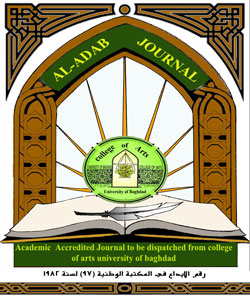Religions Viewpoints of Khalil Jubran (Khalil Gibran)
A Critical Review
DOI:
https://doi.org/10.31973/aj.v0i129.589الكلمات المفتاحية:
individualistic religion، freedom of religion، romantic، Jubran Khalil Jubran، religious viewpointsالملخص
Jubran Khalil Jubran was one of the thousands Lebanese youth who emigrated with his family to the United States because of inappropriate social, political and financial situations. Using his great potentialities, he became on of the most influential figures of the world in thinking, literary, and art dimensions.
This study attempts to investigate 1)the influential and challenging character of Khalil Jubran in the Arab world, Europe, and America; 2) the challenging religious and literary viewpoints presented by Khalil Jubran; 3) his distinguished and unique viewpoints about ontology, religion, human, and society; 4) having freedom of religious expression with a specific and non-imitative style; 5) management and guidance of the Northern Mahjar academy; 6) great realization of humanistic and moral attitudes in his works; 7)deep contemplation in human mental and behavioral states and materializing them in different works of poetry, prose and essay; and 8)lack of religious and sectarian prejudice. Although he was born to a catholic family, his personality reflected Christianity thinking, Islam, and Buddhism; and great figures such as Jesus, Imam Ali, Buddha, Abolala Moeri, William Blake, William Wordsworth, Coleridge, Nietzsche, famous European and American novelist provided him with highly valuable experiences. A lot of his viewpoints are consistent with Islamic views. A few inconsistencies are, however, observed in relation to transpiration of the soul or transmogrification, a global single or common religion, contradiction between propagating religious unity and advocacy of legitimacy of multiplicity in thinking and morality; giving love to all humans even to the cruel and murderers! and frangibility and instability of religious beliefs because of integration of the origin of his thought, which will be investigated and criticized in this study.
التنزيلات
المراجع
Amini, Amirgholi (1362). Folklore, second edition, Isfahan, University of Isfahan Publications.
Bashrooii, S. Translated by Mehrdad Entezari. (1382). Jubran Khalil Jubran, a man and a poet, first edition. Tehran, Badraghe and Namak Publication.
Dashti and Mohammadi (1418 H. H). Almojam.
Hoseini, S. R. (1366). Literary schools. Tehron, Neil and Negah Publication.
Jafari, M. (1378). Romantic History in Europe. Tehran, Markaz Nashr Publication.
Jubran, M. (1986). Al Raēd, vol.1, fifth edition, Beirut, Darol Elm for scholars Publication.
Khalil Jubran, J. (1949). Comprehensive works, Almoosighi.
Khalil Jubran, J. (1949). Comprehensive works, Damā and Ibtesamā.
Khalil Jubran, J. (1918). Comprehensive works, Al Magnoon.
Khalil Jubran, J. (1923). Comprehensive works, Prophet.
Khalil Jubran, J. (1926). Comprehensive works, Raml and Zabad.
Khalil Jubran, J. (1928). Comprehensive works, Yassoo Ibn Insan.
Khalil Jubran, J. (1949). Comprehensive works, Al Awasef.
Khalil Jubran, J. (1949). Comprehensive works, Albadaē Al Taraef.
Khalil Jubran, J. (1949). Comprehensive works, AlMawakeb.
The holy Quran
التنزيلات
منشور
إصدار
القسم
الرخصة
:حقوق الطبع والنشر والترخيص
بالنسبة لجميع البحوث المنشورة في مجلة الآداب، يحتفظ الباحثون بحقوق النشر. يتم ترخيص البحوث بموجب ترخيص Creative Commons CC BY 4.0 المفتوح ، مما يعني أنه يجوز لأي شخص تنزيل البحث وقراءته مجانًا. بالإضافة إلى ذلك ، يجوز إعادة استخدام البحث واقتباسه شريطة أن يتم الاستشهاد المصدر المنشور الأصلي. تتيح هذه الشروط الاستخدام الأقصى لعمل الباحث وعرضه.
:إعادة إنتاج البحوث المنشورة من الناشرين الآخرين
من الضروري للغاية أن يحصل الباحثون على إذن لإعادة إنتاج أي بحث منشورة (أشكال أو مخططات أو جداول أو أي مقتطفات من نص) لا يدخل في نطاق الملكية العامة أو لا يملكون حقوق نشرها. يجب أن يطلب الباحثون إذنًا من مؤلف حقوق النشر (عادة ما يكون الناشر).
يطلب الإذن في الحالات التالية:
بحوثك الخاصة المنشورة من قِبل ناشرين آخرين ولم تحتفظ بحقوق النشر الخاصة بها.
مقتطفات كبيرة من بحوث أي شخص أو سلسلة من البحوث المنشورة.
استخدم الجداول والرسوم البيانية والمخططات والمخططات والأعمال الفنية إذا لم يتم التعديل عليها.
الصور الفوتوغرافية التي لا تملك حقوق لنشرها.
لا يطلب الإذن في الحالات التالية:
إعادة بناء الجدول الخاص بك مع البيانات المنشورة بالفعل في مكان آخر. يرجى ملاحظة أنه في هذه الحالة يجب عليك ذكر مصدر البيانات في شكل "بيانات من ..." أو "مقتبس من ...".
تعتبر عروض الأسعار القصيرة معقولة الاستخدام العادل ، وبالتالي لا تتطلب إذنًا.
الرسوم البيانية ، الرسوم البيانية ، المخططات ، الأعمال الفنية التي أعاد الباحث رسمها بالكامل والتي تم تغييرها بشكل ملحوظ إلى درجة لا تتطلب الاعتراف.
الحصول على إذن
لتجنب التأخير غير الضروري في عملية النشر ، يجب أن تبدأ في الحصول على أذونات في أقرب وقت ممكن. لا يمكن لمجلة الآداب نشر بحث مقتبس من منشورات أخرى دون إذن.
قد يمنحك مالك حقوق الطبع والنشر تعليمات بشأن شكل الإقرار الواجب اتباعه لتوثيق عمله ؛ بخلاف ذلك ، اتبع النمط: "مستنسخ بإذن من [المؤلف] ، [كتاب / المجلة] ؛ نشره [الناشر] ، [السنة]." في نهاية شرح الجدول ، الشكل أو المخطط.
.jpg)























